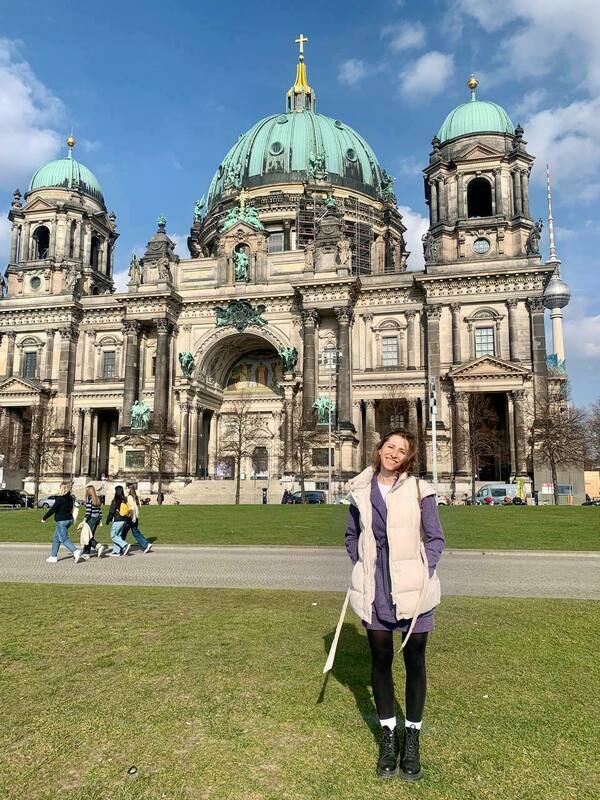
Khrystyna Kozak is currently enrolled in the Master of Global Affairs program at the Keough School of Global Affairs at Notre Dame, majoring in International Peace Studies. She is a graduate of Ukrainian Catholic University. During spring break 2024, she traveled to Berlin with the course Europe Confronts the Refugee Challenge, supported by the Nanovic Institute for European Studies as part of its EURO curriculum. In addition to this article, Khrystyna and her fellow students presented their research during an in-person poster session on April 10, 2024.
During the spring 2024 semester, I enrolled in the class Europe Confronts Refugee Challenge, taught by Professor William Donahue. This course included an immersive trip to Berlin to examine the migration situation in Germany, the third-largest refugee host country globally.
Before returning to academia, I spent five years working with forced migration at various levels with organizations such as the Norwegian Refugee Council, the UN World Food Program, and the UN Refugee Agency in Ukraine. The trip to Berlin provided valuable insights into the refugee “crisis” in Europe, which became deeply personal for me, especially considering that Ukrainians comprise around half of the refugee population in Germany.
The Russian invasion of Ukraine in 2022 caught me and my spouse in Kyiv, forcing us to flee within the country while millions fled abroad. Two years later, discussions about Ukraine in Berlin felt personal, with each meeting touching upon the topic with different connotations. Some highlighted the unprecedented solidarity and openness of Europe. In contrast, others criticized the perceived double standard towards Arab and African populations in comparison to Ukrainians, citing the simplified procedure of temporary protection activated for primarily white Christian Ukrainians on March 4, 2022.

My colleague Ethan Chiang, a first-year undergraduate global affairs student, and I decided to focus our final project on explaining how temporary protection works in Europe and comparing it with refugee and subsidiary protection. We started by covering the massive displacement that occurred in Europe after the collapse of former Yugoslavia and the war between different nationalities. At that time, each European country adopted a separate temporary protection legislation. Each nation could, thus, abandon the policy when they chose unilaterally. This fragmentation and the lessons it taught led to the adoption of the Council Directive 2001/55/EC (TPD) governing temporary protection.
In our project, we argued that the activation of TPD was not due to racial discrimination of non-European asylum seekers but to address the massive increase in displacement over a short period, as intended by the directive. For instance, comparing the influx of refugees from Syria and Ukraine to Germany, it took four years to reach the same level of displacement from Syria compared to one year for Ukraine.
We emphasized the profile of those fleeing Ukraine, which differed from typical asylum seekers, with 80% being women and children due to martial law and restrictions on men aged 18-60 crossing the border. Furthermore, 33% of Ukrainian refugees are minors, which has implications for the school systems in hosting countries.
In our project, we focused on recommendations targeting different audiences. Firstly, we addressed academia, urging the collection of data and analysis of patterns of solidarity towards other nationalities. The goal of this work would be to either confirm or debunk existing narratives surrounding refugee acceptance and support, as the data does not exist presently.
Secondly, we directed recommendations towards the European Union. We proposed that the EU extend the TPD for one year or provide more precise, longer-term solutions to ensure non-refoulement, particularly in extreme situations.
While temporary protection may seem favorable from the outside, it remains the least desired option for millions of Ukrainians who want to return to a safe and peaceful home.
Lastly, we provided recommendations for INGOs and the UN. We emphasized the importance of enhancing social cohesion not only between host communities and refugees but also among different groups of refugees within the same country. By fostering cooperation and avoiding competition for refuge, we can promote greater unity and support among all those affected by displacement.
Unfortunately, the situation in Ukraine continues to deteriorate, yet media coverage of ongoing air attacks and casualties has significantly decreased. General fatigue towards the Russian war against Ukraine has set in quicker than expected, despite the hardships faced by Ukrainians. My only hope is that my home remains undamaged by Russian missiles, allowing me to return after completing my education at Notre Dame.
However, the trip to Berlin illuminated the stark reality that while temporary protection may seem favorable from the outside, it remains the least desired option for millions of Ukrainians who want to return to a safe and peaceful home.
Watch Khrystyna and Ethan's presentation and more student presentations in the video below.